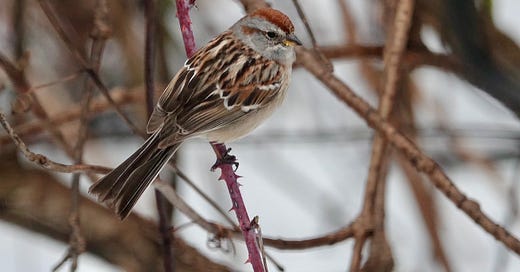Naturally
The January day was headed to perfection, but it was a long trip, even if it knew a shortcut. It was -20 degrees and it was windy. That’s an invitation to stay indoors. My Mama didn’t raise any fools, so I waited until it warmed up to -18 degrees, a less than drastic improvement, before heading outside. I tried to do the right thing by my neighbors by feeding the birds. Birds are my neighbors. It was quiet as I trudged along briskly, if a person can trudge along briskly. Then, I heard the voice of a harbinger of hope. A white-breasted nuthatch sang its spring song—a rapid, nasal, “way-way-way-way.” The bird gave voice to an appreciation for a new day.
Q&A
“How does a woodpecker keep from getting woodchips in its nostrils?” A woodpecker's nostrils or nares have stiff feathers around them. These feathers filter out woodchips and sawdust, and lessen the number of work comp claims.
“I heard you talk about an old saying about daddy longlegs helping farmers find cows. Tell me again.” If the cows are lost, find a granddaddy longlegs and say to him, “Granddaddy, granddaddy, where are the cows?” It will lift one of its legs and point in the direction where the cows are to be found. They don’t always tell the truth.
Ken Nelson of Clarks Grove asked why there are so many mice in houses this year. There are two main things attracting mice to your house—food and shelter. Perhaps birds of prey have had an easier time catching mice with less snow cover for the rodents to use for hiding. A house is a safe haven. While house mice inhabit homes throughout the year, deer mice and white-footed mice prefer to dwell outdoors, and establish shelter within dwellings in order to escape the winter weather. A pest exterminator told me mice can enter through openings as small as a dime. Maybe mild winters have led to more resources, which resulted in more mice. One mouse leads to more mice because they detect the odors of food and other mice. Voles seldom enter houses. Voles, also known as meadow mice, are herbivores that eat grasses, sedges, herbs, seeds, grains, tubers, bulbs, fruits, tree bark and roots. They may be mistaken for another small mammal that does occasionally get into houses: the northern short-tailed shrew that eats voles, mice and insects. The subnivean zone is a hollow space between the ground and the base of the snowpack. It’s a humid winter habitat with a stable temperature of around 32 degrees. Voles and mice live there. They sometimes cache food. Shrews could live there and weasels might hunt the subnivean.
“Why do I see more Cooper’s hawks today than in the past?” Called chicken hawks by colonists because they plucked poultry from farms, Cooper’s hawks were often shot before the 1940s. Logging and development diminished the hawks’ forest habitat, and pesticide use in the mid-20th century led to eggshell thinning, which further depleted populations. Pesticides such as DDT were curbed, and protections from hunters were initiated in the 1960s, causing populations of woodland avian predators like Cooper’s and sharp-shinned hawks to soar. These accipiters are drawn to birdfeeders.
“Why are so many owls hit on the roads?” Some owls commonly forage at the same height as vehicles, making them prone to vehicle collisions. Spilled grain, bags of chips, half-eaten cheeseburgers and beverage containers litter the edges of our roadways. Rodents love to snack on discarded food scraps and grains, and the owls love to snack on the rodents that love to snack on those food scraps and grains. Once an owl zeroes onto a mouse or vole (the potato chip of the prairie) prey item, it doesn’t notice traffic. Owls hunt at low altitudes at night, flying close to the ground where vehicles are traveling.
“How did barn owls get their name?” Barn owls were around before barns. Maybe barns were named after them? The barn owl's genus name is Tyto, which is Greek for “owl,” and the species name is alba, which is Latin for “white.” So, the translation is “white owl.” The common name refers to the barn owl's frequent use of barns and other manmade structures. Its nicknames are ghost owl, monkey-faced owl and sweetheart owl.
Thanks for stopping by
“There are those who argue that everything breaks even in this old dump of a world of ours. I suppose these ginks who argue that way hold that, because the rich man gets ice in the summer and the poor man gets it in the winter, things are breaking even for both. Maybe so, but I'll swear I can't see it that way.”—Bat Masterson.
“I have decided to stick with love. Hate is too great a burden to bear.”—Martin Luther
King, Jr.
Do good.
©Al Batt 2025
The American tree sparrow is sometimes called a “winter chippy” because it has a rusty cap like the chipping sparrows that nest in Minnesota. American tree sparrows forage and nest on the ground, breeding at or above the treeline, migrating down to balmy Minnesota in late autumn. Photo by Al Batt.





Wow. And to think I only knew Bat Masterson from the TV show. ;)
Birds are my neighbors too. Bless you Al Batt for feeling that way.
As for the mice and the dime, well, I guess I can quit trying to stop cracks with stainless steel wool. I do grieve for having to take the lives of these small creatures when they make home in my kitchen, but ew, the brown lines along the baseboards and in the corners. The pellets in the cupboards.
As for what Barn Owls were called before barns, now that is a deep subject that we may never know the answer to. I would like to know what they call themselves.